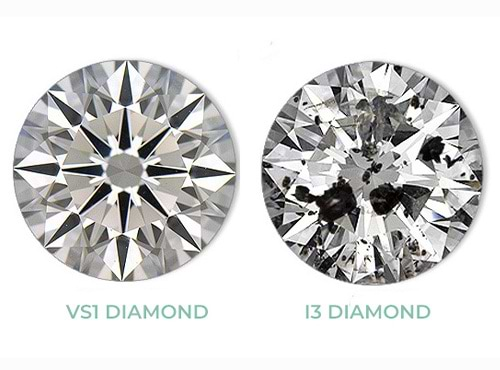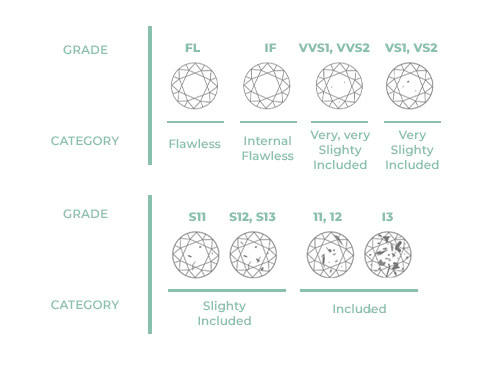The 4 C’s: Clarity
Understanding the 4 C’s will help you find the perfect diamond for your partner
Diamond Clarity
This characteristic refers to the natural imperfections on and within a diamond, or its lack of them. These imperfections can also be called flaws or inclusions. They form during the diamond’s growth process and appear uniquely on each stone.
Imperfections within or on the surface of a diamond are natural, but their presence can affect the appearance and even the durability of the stone.
Clarity impacts the stone’s ability to let light pass through the stone. Inclusions can cause dispersion blockages, which in turn affects the diamond’s overall brilliance and sparkle. The fewer inclusions a diamond has, the more rare and valuable it will be considered. Flawless diamonds, or stones with no imperfections, are the most prized.
Diamond Clarity Grades
Diamond Clarity Grades
All diamonds are graded based on their clarity. Grading is determined by closely examining the diamond under 10X magnification. A gemologist will note the quantity, relief, and placement of inclusions to identify the clarity grade.
The clarity grading scale runs from Flawless (FL) to Included (I3). Some grades have different categories within the grade, like Very Very Slightly Included 1 and Very Very Slightly Included 2. The higher the number after the grading, the more inclusions will be visible on and within the diamond.
- Flawless (FL). No imperfections or inclusions on the diamond’s surface. This is the rarest and most valuable type of diamond.
- Internally Flawless (IF). No visible imperfections or inclusions on the diamond’s surface, even under magnification. Although the diamond appears flawless, it still may have very minor inclusions that are difficult to see.
- Very Very Slightly Included 1 (VVS1) & Very Very Slightly Included 2 (VVS2). No visible imperfections or inclusions to the untrained eye. Minor inclusions may be visible under magnification.
- Very Slightly Included 1 (VS1). Small imperfections or inclusions may be visible under close inspection.
- Very Slightly Included 2 (VS2). More minor imperfections or inclusions may be visible.
- Slightly Included 1 (SI1), Slightly Included 2 (SI2) & Slightly Included 3 (SI3). Small imperfections and inclusions are visible, even to an untrained eye.
- Included 1 (I1), Included 2 (I2) & Included 3 (I3). Imperfections and inclusions are clearly visible.
The most prized diamonds are called “eye clean diamonds.” This term refers to diamonds whose inclusions cannot be seen without magnification. They are usually graded VS1 or higher.
Clarity In Diamond Shapes
The shape of a diamond can affect its clarity. This is because certain shapes hide imperfections better than others.
Brilliant cut shapes, such as round and princess, are better at hiding imperfections than step-cut shapes, such as emerald and asscher. The large, open tables of step-cut shapes make inclusions more visibly noticeable, while the high level of facets in a brilliant cut make inclusions more difficult to spot. This isn’t to stay step-cut diamonds should be avoided. You’ll just need to opt for step-cut stones with a higher clarity grade.
Generally, the best diamond shapes for hiding inclusions are brilliant cuts in round, cushion, oval, radiant, or pear forms. You can choose diamonds with clarity grades as low as SI1 or SI2 with these shapes.
Pay close attention to the clarity grade if you’re looking for a diamond with a clean sparkle and impeccable brilliance. Any brilliant cut diamond with a grading of VVS2 or higher should meet your needs, but look for VS2 or higher for step-cut diamonds.

Diamond Clarity & Color
All 4 Cs work together in harmony, but clarity and color can have an even more direct correlation with each other.
Jewelers recommend balancing color and clarity when shopping for a diamond:
- If you’re shopping for a diamond in the D-F color range, look for one with a clarity grade of VS2 or higher
- If you’re shopping for a diamond in the G-I color range, look for one with a clarity grade of SI or higher
Determining Clarity In Lab Grown Diamonds
Lab grown diamonds tend to have higher clarity grades than mined diamonds because they are grown in controlled lab environments. However, this doesn’t mean that they are all flawless. Even lab grown diamonds can have imperfections that affect their clarity grade.
Small metallic inclusions are possible within lab grown diamonds. Since they are created using high pressure and high temperature, remnants from the metallic flux that transports carbon gas to the diamond seed can be found within the diamond. These remnants are usually only visible under magnification, but they do count as inclusions. Other lab grown diamonds are created using chemical vapor deposition, which can cause microscopic amounts of graphite to form around the diamond seed as it grows.
Lab grown diamonds follow the same clarity grading scale as mined diamonds, so you can look for diamonds with the same ratings as mined diamonds to find your perfect sparkle.
More FAQs about Lab Grown Diamonds